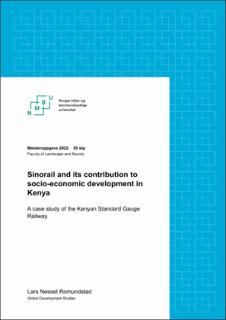| dc.description.abstract | The standard gauge railway connecting the port city of Mombasa to the capital of Nairobi was finished in 2017. With a 90% financing from the China Export-Import Bank (EXIM Bank), the ambition was to reduce cost, and travel time for passengers and cargo. Initially, the railway was planned to run from the coast, all the way to Uganda. However, high costs have seen the project scale down, and currently ends at Naivasha Dry Port Container Depot just outside of Nairobi. This thesis examines the projects’ impact on the socio-economic development of Kenya and highlights some key drivers for Kenya’s multi-billion-dollar gamble.
The SGR can be seen in connection to China’s 2013 Belt and Road Initiative (BRI) to increase connectivity by land, air, and sea to provide easier and more efficient trade routes in central and south-east Asia, Africa, and Latin America. Ports, railways, airports, and other big infrastructure projects has been constructed in more than 165 countries and is estimated to reach $2 trillion dollars by the 2030s (Nugent & Lu, 2021). Kenya’s development plan Vision 2030 aims to increase its economic growth and battle the country’s poverty and governance challenges. Borrowing from China is a key to achieve these goals.
This thesis finds that Kenya might have over-reached in its ambition to modernize, and to close its infrastructure gap. The country’s debt to foreign lenders has increased dramatically, forcing its way into budgetary prioritizations. Concerns that the SGR might become a very expensive white elephant is found to be partially justified, but there is hope that Kenya will overcome its fiscal challenges in the years to come.
Key drivers for the SGR are identified as political optics, Chinas expansion through the Belt and Road Initiative, corruption, and regional geopolitical competition. | en_US |

